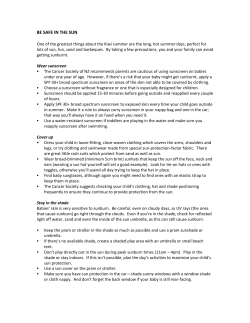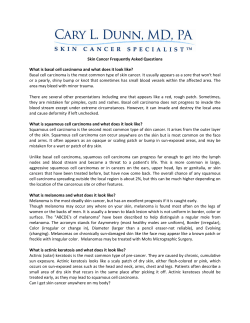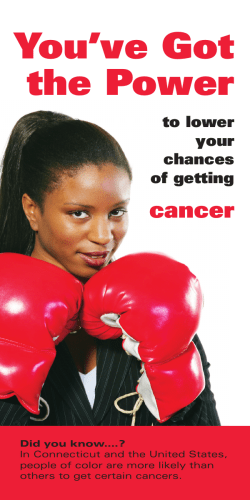
Document 144502
therapy and surface chemotherapy, but most skin cancers are removed by surgical exci sion. Pre-cancers can be easily removed by freezing with liquid nitrogen. In gardening, wind, fertilizers, pesticides, soil and other skin irritants may worsen the effects of sunlight. No one is invulnerable. Dark-skinned ethnic groups can get tans, freckles, and wrinkles. Although skin cancer is rare with this skin type, if it occurs, it can be more severe. Ethnic groups that have light skin should follow the rules closely about sun exposure. Sun Damage Prevention Protect your children. Damage to their skin now will have serious effects in future years. Plan summer work so that inside activities occur from 10 a.m. to 2:00 p.m. to avoid being outside during the hours of most intense sunlight. Don’t forget, it is possible to burn on an overcast day. When working outside, cover skin with gloves, a hat with ear and neck protection, long sleeves, and pants. Button up the neck of long sleeve shirts. Light cotton reflects heat and is cooler for working outdoors. On skin that can’t be covered with cloth ing, use an SPF 15-50 sunscreen. SPF (sun protective factor) is a measure of effective ness in preventing sunburn. A sunblock is different from a sunscreen and may protect against more ultraviolet rays. Look for a block containing a titanium oxide if you are very sunlight sensitive. The new “sport” sun screens are less likely to sweat off. Other wise, if working and sweating, reapply the sun screen or block every hour. Even with a sunscreen on it is still possible to get burned. Reapplying the sunscreen doesn’t extend the time of protection, it only replenishes what sweats off. And don’t forget a sunblock for lips. Chapped lips may really be sunburned. Generously apply sunscreens and sunblocks 30 minutes before sun exposure. Sunscreen chemicals take time to bind to the skin’s surface. Wear a hat to cover your forehead. By not applying a sunscreen there, one can avoid sting ing eyes from sunscreen chemicals in sweat. Gardening and Your Health: Eye Protection Don’t neglect your eyes in sunlight. Studies have shown an increased risk of early cataract formation with prolonged sun exposure. Protect eyesight with sunglasses, but don’t get extreme ly dark lenses. Behind darker lenses eyes dilate, allowing more ultraviolet light to enter the eyes. Buy good quality glasses coated with a UVA blocking filter. Prepared by Mary Predny from an article written by Bonnie Appleton and Sam Selden for NMPro magazine Project Director: Diane Relf Reviewers: Dawn Alleman, Bonnie Appleton, Traci Gilland, Alan McDaniel Publication 426-063 www.ext.vt.edu Produced by Communications and Marketing, College of Agriculture and Life Sciences, Virginia Polytechnic Institute and State University, 2009 Virginia Cooperative Extension programs and employment are open to all, regardless of race, color, national origin, sex, religion, age, disability, political beliefs, sexual orientation, or marital or family status. An equal opportunity/affirmative action employer. Issued in furtherance of Cooperative Extension work, Virginia Polytechnic Institute and State University, Virginia State University, and the U.S. Department of Agriculture cooperating. Rick D. Rudd, Interim Director, Virginia Cooperative Extension, Virginia Tech, Blacksburg; Alma C. Hobbs, Administrator, 1890 Extension Program, Virginia State, Petersburg. Sunburn & Skin Cancer Sunburn Most people have suffered from at least one bad sunburn. The beginning of a sunburn is shown by hot, pink skin. Later comes swelling, burning pain, and possibly blistering. As the burn leaves, peeling inevitably appears. Peel ing means that the skin is thickening up to pro tect itself from further sun damage. If burned skin continues to get exposed to sun, damage can’t be repaired. Even if damage is not visi ble, skin cells mutate with each sun exposure. Over a lifetime these mutations may add up to cancer, a problem seen on gardeners who work unprotected in the sun. A severe sunburn is one of the biggest risk factors in getting a melano ma skin cancer. Sunburn Treatment There is no way to stop, stall, or reverse a developing sunburn. Aspirin or ibuprofen helps the pain and cool water soaks help the swelling and redness. Sitting in front of a fan may help too. Creams, lotions, or sprays con taining 1% hydrocortisone may help ease pain and itching. Menthol-containing products are soothing. Be forewarned that many over-the-counter burn remedies contain local anesthetics (caines). These anesthetics are not only unnecessary, but may cause allergic rashes. Skin peeling after a burn can be hidden with a moisturizer cream or lotion. A severe, wide spread, blistering sunburn should be checked out by a dermatologist as soon as possible. To insure that skin recuperates completely from a sunburn, spend a minimum of 2 weeks out of the sun. The consequence of staying in the sun will be another, nastier burn. Skin Cancer In addition to preventing sunburn, taking measures to protect against the sun can also prevent chronic, ugly, or harmful changes in skin. Long term exposure to ultraviolet rays causes damage first to the surface epidermis, then to deeper tissues. Over time, damage occurs to pigment-making cells and elastic tis sue, resulting in blotchy color in sun-exposed skin. “Broken” enlarged veins occur as the elasticity of blood vessels is weakened. Over time, as your outer skin layers thin out and the ability to repair sun damage declines, the pro cess accelerates. Much of what is considered normal skin aging is really the result of life-long exposure to sunlight. “Liver spots,” “crows-feet,” rough “chicken skin,” “red necks,” and easy bruising on hands and arms are all signs of this expo sure. Initially, when cancerous cells develop, they spread out and multiply on the surface of the skin; they can’t invade deeply to become true cancers. Malignant surface cells, battling with the body’s immunity, create pre-cancers. These rough, red spots may first appear on surfaces most exposed to sun light: tops of ears, bald spots, noses, temples, lower lip, and tops of hands. These spots may initially come and go. Once they persist, some may get progressively more crusty, red, sore and thickened. They may develop into skin cancers as malignant cells break through and spread into deeper skin layers. Skin cancers may be recognized as red spots or bumps that may bleed easily. Their growth may be slow, as on the body, or faster, as on the thin skin of the face. Most common, and usually least intrusive of the skin cancers, are basal cell carcinomas. These lesions frequently bleed, but infrequently hurt. Although they can invade deeply into the skin they rarely metastasize (spread into the body). Squamous cell cancers run a greater risk of metastasizing if allowed to grow deeply. This is especially true of squamous cell cancers on the lower lip. These cancers appear usually as red, crusty growths, but they may also ulcer ate. The most serious skin cancers are melan o mas. These skin cancers are the most likely to be terminal, often metastasizing early. Mela nomas are far less common than basal cell and squamous cell cancers, but the growing number of melanomas, and the growing num ber of people killed by them, have profession als concerned. Melanomas appear to have their origin in childhood sun exposure. Unlike the more common skin cancers - which increase in number as one grows older - melanomas are beginning to appear in individuals in their 30’s and 40’s. Skin Cancer Detection and Treatment Individuals who have previously had a skin cancer, or are at greater risk for such cancers because of pre-cancers, family history, or fair ness of skin, should check sun-exposed skin on a monthly basis for red or non-healing lesions. Beware of sores that bleed easily. Large, flat moles should be watched on a monthly basis, even if they are not on exposed skin. Early detection of skin cancers means early removal. Treatment options include radiation
© Copyright 2025





















